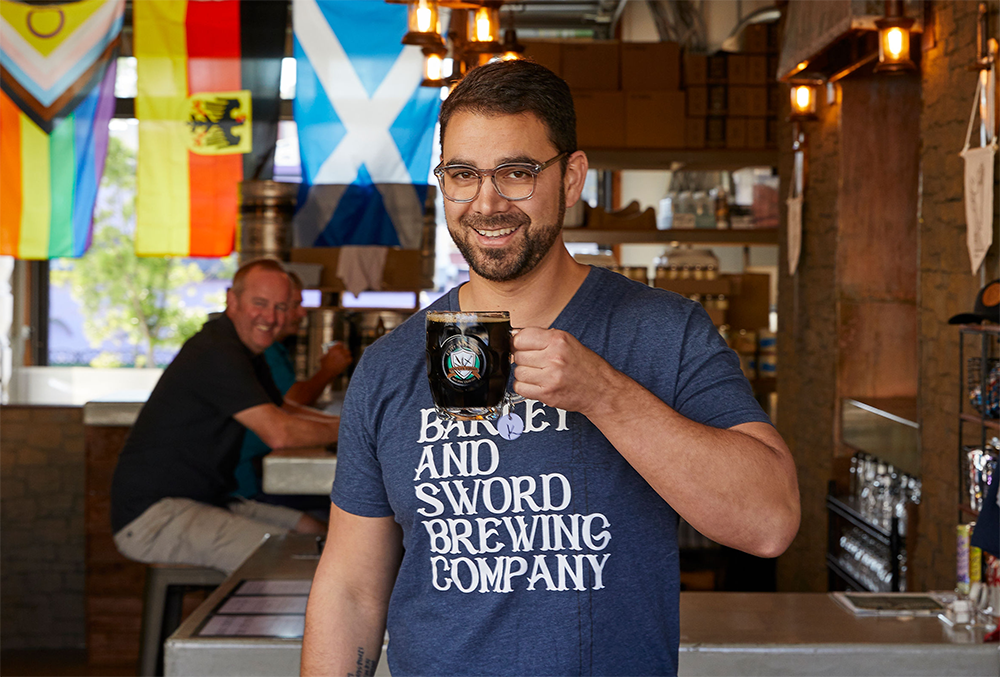
Craveology Cafe and the North Star Science Store are temporarily closed for renovation.

To celebrate the 10th anniversary of the Two Scientist Walk into a Bar program, the Fleet Science Center has collaborated with Barley and Sword Brewery to create a delicious beer for the occasion. And what better way to do this than to involve scientists in the beer-making process? A handful of scientists from the Two Scientists program were selected, and everything started with a meeting at the brewery for a brainstorming session.
Mike, the owner of Barley and Sword Brewery, welcomed us with open arms and delicious beers, and we started putting our heads together on how to best create a beer worthy of this special occasion. Similar to the Two Scientists Walk into a Bar program, the beer needed to appeal to a broad range of people, contain the perfect chemistry of malt, hops, and yeast, and have a refreshingly crisp taste. Simply put, it had to be an ideal brew to enjoy during a celebration!
With these criteria, it quickly became clear that the only beer that would fulfill all requirements was a Festbier. A Festbier is a type of German lager that has been traditionally associated with Oktoberfest celebrations, but this style of beer is often served during other festivals as well. After having decided on a style, Mike came up with a recipe, ordered all the ingredients, and set a date for the brew. We went home excited to soon be able to bring the celebration beer to life!

On brew day, we met early in the morning to get started. Mike patiently explained all the details of the process and let us examine the ingredients and the equipment before starting. Mike also showed us his digital brewing recordkeeping book, which closely resembled a lab notebook. Brewing beer is a science -- a series of chemical reactions, and each step must be planned out and precisely documented. Parameters such as temperature, pH, and duration of each step can significantly affect the end result. We would take several samples of the beer in progress during the brewing and document its characteristics as we went along.

The first step in the brewing process is mashing, where crushed malts (a type of grain) and warm water are combined, like making oatmeal or porridge, to break down the malt into fermentable sugars. The temperature during mashing is crucial because it directly affects how much starch gets converted to sugars, affecting the beer's final characteristics. For a Festbier, lower temperatures are preferred because this generally leads to lighter-bodied beer with a drier finish.



Next, the wort (the liquid extracted from the mash) is separated and brought to a boil. During boiling, we added the hops to the wort for bitterness and aroma. A Festbier has a balanced bitterness that complements its malt sweetness without being overpowering. To achieve this flavor profile, we added the hops at the start of the boil to extract the bitterness from the hops. It was essential to keep the boiling temperature as consistent as possible so the chemicals from the hops that provide flavor and bitterness were evenly extracted, and we got a deliciously balanced flavor profile.


After boiling, we cooled the wort rapidly to prevent the development of any unwanted flavors and prepare it for the most important part - fermentation! During fermentation, the added yeast converts the sugars from the wort to alcohol and provides other flavors to the final beer. For the Festbier, it is important to select a German lager yeast strain, known for its clean fermentation profile and perfectly complements the beer's maltiness. Lager yeasts are fermented at a cooler temperature than ales to produce a clean beer with minimal funky flavors (for comparison, many of the craft beers in San Diego are ales, which use a yeast that ferments at higher temperatures to produce a variety of unique flavor compounds). Getting up to this point took about 7 hours, but finally, our work was done. All we had to do now was wait. Our beer needed to ferment for 2-3 weeks. Festbiers then have to undergo a lagering process of 4-6 weeks to ensure flavor maturation, better clarity, and a smoother final beer.


We can't wait to try this anniversary Festbier that we were invited to be part of on September 13th with the San Diego community! Join us at 6 p.m. at Barley and Sword Brewery to find out for yourself how successful our beer science experiment was. There will be a keg ceremony, raffles with great prizes, and plenty of scientists to answer any of your questions. Raise your glasses and cheer with us to celebrate the next ten years of thinking and drinking!